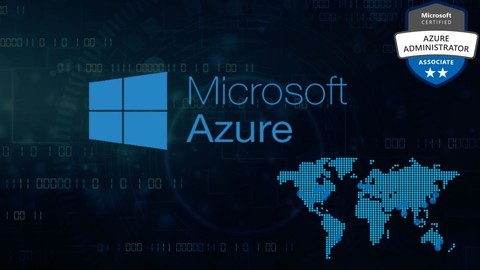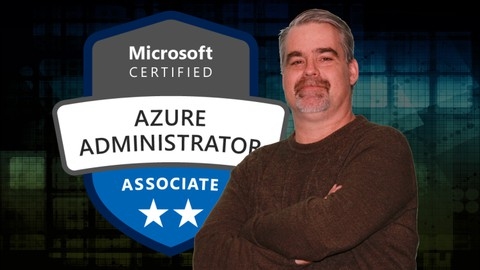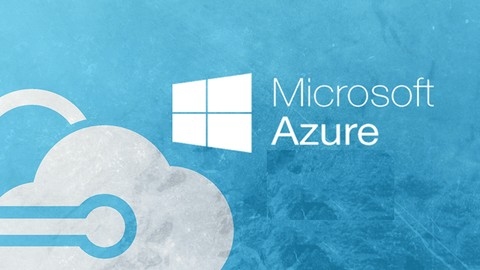The Microsoft Azure Administrator Associate certification (AZ-104) is a highly sought-after credential that validates your ability to manage and administer cloud resources on the Azure platform.
Earning this certification opens doors to exciting career opportunities in cloud computing, demonstrating your expertise in managing virtual machines, networks, storage, security, and other core Azure services.
However, finding the right AZ-104 preparation course on Udemy can be a challenge, with numerous options vying for your attention.
You’re looking for a course that is comprehensive, engaging, and taught by industry experts, ensuring you’re well-prepared to tackle the exam and confidently manage Azure resources in real-world scenarios.
Based on our thorough review, the “AZ-104 Microsoft Azure Administrator Exam Prep - OCT 2023” course stands out as the best overall option.
This course features a comprehensive syllabus, covering all the key topics you need to master for the AZ-104 exam, and includes hands-on labs to solidify your understanding.
This is a great choice for those who want to become a certified Azure administrator.
While this is our top pick, there are other valuable options to consider.
Continue reading to explore our recommendations for different learning styles and goals, including courses focused on specific Azure services and those emphasizing hands-on practice.
AZ-104 Microsoft Azure Administrator Exam Prep - OCT 2023
This comprehensive syllabus covers all the key topics you need to prepare for the Azure Administrator certification exam.
The course starts with an overview of Azure concepts, services, and resources like Virtual Machines (VMs), App Services, Storage, and Networking.
You’ll learn how to use PowerShell and the CLI to manage Azure, as well as how to work with Microsoft Entra ID (formerly Azure Active Directory) for user and group management.
A major focus is on role-based access control (RBAC) and governance, where you’ll dive into assigning roles, creating custom roles, applying policies, and using resource locks.
The syllabus also covers managing subscriptions, cost analysis, budgets, and resource tagging.
For storage, you’ll learn to configure access, redundancy, tiers, and data protection options like soft delete and versioning for Azure Blobs and Files.
The course guides you through deploying VMs, scaling with VM Scale Sets, and automating deployments using ARM templates and tools like Bicep and Terraform.
Networking is another key area, covering virtual networks, subnets, peering, gateways, DNS, network security groups (NSGs), and load balancing.
You’ll also explore monitoring with Azure Monitor, enabling diagnostics, and running queries.
The syllabus dives into backup and recovery solutions like Azure Backup and Azure Site Recovery for VM replication and failover.
Additionally, it covers modern app deployment with Azure Kubernetes Service (AKS), Azure Container Instances, and Azure Container Registry.
Hands-on labs are included throughout, allowing you to practice concepts like creating VMs, deploying ARM templates, configuring networking, and setting up load balancing.
The course wraps up with exam tips and a practice test to gauge your readiness.
AZ-104 Microsoft Azure Administrator Certification
You’ll start by learning how to create an Azure free account and navigate the Azure portal.
The course then dives into deploying and managing Azure compute resources like virtual machines (Windows and Linux), web apps, containers, and Kubernetes clusters.
You’ll learn to configure networking components such as virtual networks, subnets, network security groups, load balancers, and application gateways.
Storage is a crucial aspect covered, including blob storage, file shares, access tiers, replication, and securing storage accounts.
The course teaches you to implement Azure Active Directory for identity and access management using role-based access control (RBAC), multi-factor authentication (MFA), and conditional access policies.
Monitoring Azure resources is essential, and you’ll learn to use Azure Monitor for alerts, log analytics workspaces, and custom logging.
Backup and disaster recovery solutions like Azure Backup and Azure Site Recovery are also covered.
The course equips you with skills to automate deployments using PowerShell, Azure CLI, ARM templates, and the Bicep language.
You’ll practice creating resources like virtual networks, storage accounts, and virtual machines through code.
Hands-on labs reinforce concepts like configuring virtual machine disks, availability sets, scale sets, custom script extensions, and network watcher.
You’ll also learn to secure resources using Azure Firewall, private endpoints, and virtual network peering.
Microsoft AZ-104:Azure Administrator Exam Certification 2023
The course starts with an introduction to Azure, guiding you through accessing the portal and providing an overview of the cloud platform.
You’ll learn about managing Azure subscriptions, analyzing resource utilization, working with resource groups, and implementing role-based access controls (RBAC) for secure access management.
Moving on, you’ll dive into storage solutions, including creating and configuring storage accounts, importing and exporting data, setting up Azure Files, and implementing Azure Backup for data protection.
Virtual machines are a core part of the curriculum, covering the creation and configuration of VMs for Windows and Linux, automating deployments, managing VM storage and networking, ensuring high availability with availability sets and zones, and scaling with VM scale sets.
You’ll also explore disk caching and encryption techniques.
Networking is another crucial area, covering virtual network implementation, connectivity between VNets, name resolution with DNS, configuring network security groups (NSGs), load balancing with Azure Load Balancer and Application Gateway, and network monitoring with Network Watcher.
Identity management is a key focus, with lessons on managing Azure Active Directory, implementing hybrid identities with AD Connect, and enabling single sign-on (SSO) and multi-factor authentication (MFA).
You’ll also learn about business-to-consumer (B2C) and business-to-business (B2B) scenarios.
The course delves into infrastructure as code with Azure Resource Manager (ARM) templates, covering template authoring, functions, and linking.
Additionally, you’ll explore Azure Automation for automating tasks and managing configurations.
For the AZ-104 exam, the syllabus includes a dedicated section on containers, covering Docker, Azure Kubernetes Service (AKS), and deploying containerized applications.
Throughout the course, you’ll have access to demos, PowerShell scripts, study materials, and lab guides to reinforce your learning and provide hands-on experience.
AZ-104: Microsoft Azure Administrator - Full Course
The course starts with an overview of Azure services and the Azure portal, giving you a solid foundation.
It then dives deep into critical topics like Identity and Access Management (IAM) using Azure Active Directory.
You’ll learn about Azure AD features, multi-factor authentication, self-service options, and integrating with on-premises Active Directory using Azure AD Connect.
A major section is dedicated to Azure governance and compliance aspects like management groups, subscriptions, resource tagging, role-based access control (RBAC), and Azure Policy.
These are crucial for administering Azure resources effectively.
The course covers core Azure administration skills like using PowerShell, the Azure CLI, ARM templates, and the Cloud Shell.
You’ll learn to manage resource groups, virtual networks, load balancers, traffic routing, and interconnectivity options like VNet peering and ExpressRoute.
For storage, it covers Azure Storage accounts, blob storage, file shares, security options like shared access signatures (SAS), and data replication strategies.
Virtual machines are another focus area, including deploying VMs, availability sets, extensions, and managing Linux instances.
Serverless computing concepts like App Services, containers, Azure Kubernetes Service (AKS), and container registries are also included.
Data protection mechanisms like Azure Backup and Site Recovery are covered in-depth.
Monitoring is a key operations area, with the course explaining Azure Monitor components like Log Analytics, alerts, Azure Advisor, and Network Watcher tools.
The syllabus is regularly updated and even includes recent additions like Azure File Sync, Import/Export service, AzCopy, and Content Delivery Networks (CDNs).
Practice tests are provided to gauge your readiness.
Azure Administrator: AZ-104
You’ll start by learning how to navigate the Azure portal, use Cloud Shell, and work with PowerShell and the Command Line Interface (CLI).
The course covers managing Azure resources, including resource groups, locks, tags, and ARM templates.
Next, you’ll dive into virtual machines, exploring disks, extensions, availability sets, scale sets, and creating VMs with PowerShell, CLI, and the portal.
The course guides you through Azure Storage services like blobs, files, and secure transfer.
You’ll also learn about virtual networking concepts like vNets, IP addressing, DNS, Network Security Groups (NSGs), and Azure Bastion connectivity.
The syllabus covers inter-site connectivity solutions like vNet peering, VPN gateways, and ExpressRoute.
You’ll learn to implement load balancing with Azure Load Balancer and Traffic Manager.
The course also covers monitoring with Azure Monitor, Activity Log, Alerts, Metrics, and Network Watcher.
Data protection is a key focus, covering backup strategies for VMs and file shares using Azure Backup and Azure Site Recovery.
Azure Active Directory (Azure AD) is explored in-depth, including user/group management, Azure AD Connect for hybrid environments, Multi-Factor Authentication (MFA), and Azure Identity Protection (AIP).
You’ll learn about Azure subscriptions, Role-Based Access Control (RBAC), management groups, and Azure Policy for governance.
The syllabus covers data services like Content Delivery Network (CDN), Azure File Sync, and DataBox.
Finally, you’ll explore app services, containers with Docker, and container orchestration with Kubernetes.
The course also covers Application Gateway, Azure Front Door, and Web Application Firewall (WAF).
[NEW] AZ-104: Microsoft Azure Administrator - Oct 2023
This course covers a comprehensive range of topics essential for the AZ-104 certification exam.
It starts with an introduction to cloud computing concepts, Azure subscriptions, and the Azure portal.
You’ll learn about Azure Active Directory (AAD), user and group management, multi-factor authentication, and conditional access policies.
The course dives deep into role-based access control (RBAC) and how to configure it.
You’ll gain insights into Azure subscriptions, governance tools like Azure Policy, resource locks, and cost management.
The syllabus extensively covers Azure storage services like Blob, File, Queue, and Table storage, along with security and management aspects.
Virtual machines are a core focus area, covering deployment, configuration, high availability, scalability, and automation using ARM templates and Bicep.
You’ll learn about Azure App Service, containers (Docker, ACI), and Kubernetes.
The networking section is comprehensive, covering virtual networks, subnets, routing, DNS, network security groups, Azure Firewall, load balancing, and Application Gateway.
You’ll also learn about network monitoring with Network Watcher.
The course covers Azure Monitor for metrics, logs, and alerts, along with Log Analytics and Application Insights.
It teaches you about backup and disaster recovery solutions like Azure Backup and Azure Site Recovery.
You’ll get hands-on experience with PowerShell and the Azure CLI for managing Azure resources.
The syllabus also includes practice tests, Microsoft official labs, and study guides to prepare for the AZ-104 exam.
AZ-104 Exam Prep: Microsoft Azure Administrator
This course covers all the key areas you’d expect for the AZ-104 exam, including managing Azure AD objects, configuring Azure subscriptions, self-service password reset, multi-factor authentication, role-based access control, storage accounts, virtual machines, virtual networks, name resolution, high availability, monitoring with Network Watcher, VM backups, Azure Site Recovery, resource consumption analysis, and more.
One standout feature is the inclusion of interactive, hands-on labs from labIT PRO Lite that you get free access to.
These allow you to practice concepts in a simulated Azure environment without needing an actual Azure subscription.
The course have a good mix of lectures explaining concepts along with these hands-on labs to reinforce the learning.
The syllabus is quite detailed, with new sections covering the latest Azure AD, subscription, and storage account management topics.
You’ll learn how to create and manage users, groups, administrative units, and configure device settings in Azure AD.
For subscriptions, it covers management groups, policies, locks, cost management, tagging, and resource groups.
The storage section looks at creating accounts, configuring network access, shared access signatures, access keys, and replication options.
For virtual machines, you’ll deploy Windows VMs, resize them, redeploy, move between resource groups, use availability sets/zones, configure load balancing, and more.
Networking topics include virtual networks, peering, site-to-site VPNs, DNS configuration, and using Network Watcher for monitoring.
The backup and recovery sections guide you through Azure Backup for VMs as well as using Azure Site Recovery for failover.
You’ll also learn to analyze resource consumption metrics and set up alerts across your Azure subscription.
AZ-104 Microsoft Azure Administrator course with SIMULATIONS
The course starts by laying a solid foundation, ensuring you understand the Microsoft environment, Active Directory domains, remote access services (RAS), demilitarized zones (DMZ), virtualization, and Microsoft’s cloud services.
It even addresses the renaming of Azure AD, a crucial update you don’t want to miss.
You’ll learn how to manage Azure AD users, groups, licenses, and administrative units, as well as configure self-service password reset.
The course dives into using command-line tools like PowerShell and Bash to interact with Azure resources, a must-have skill for administrators.
Access management is a critical aspect covered in-depth, including role-based access control (RBAC), custom roles, and assigning roles at different scopes.
You’ll also learn to manage Azure subscriptions, governance, costs, resource groups, tags, policies, and resource locks.
Storage is a significant focus, with modules dedicated to configuring access, managing storage accounts, redundancy, encryption, and working with Azure Files and Blob Storage.
You’ll even learn to use Azure Storage Explorer and AzCopy for data management.
Automation is key, and the course teaches you to interpret, modify, and deploy ARM templates and Bicep files, as well as deploy virtual machine (VM) extensions.
Virtual machines are a core part of the Azure ecosystem, and you’ll learn to create, configure, manage, and move VMs between resource groups.
The course covers VM sizing, data disks, network settings, availability options, and VM scale sets.
Containers are the future, and you’ll gain insights into Azure Container Instances, Azure Kubernetes Service (AKS), storage, scaling, networking, and upgrading AKS clusters.
Web applications are essential, and the course covers creating and configuring Azure App Services, including plans, scaling, security, custom domains, backups, networking, and deployment settings.
Networking is a crucial aspect, with modules on virtual networks, subnets, peering, IP addresses, user-defined routes, network security groups (NSGs), Azure Bastion, service endpoints, and private endpoints.
Name resolution and load balancing are also covered, with lessons on Azure DNS, load balancers (internal and public), load balancing rules, NAT rules, and Azure Application Gateway.
Monitoring is vital for any administrator, and you’ll learn to configure and interpret metrics, Azure Monitor Logs, log queries and analysis, alerts and actions, and monitoring for VMs, storage, networks, and on-premises connectivity using VM insights and Azure Network Watcher.
Finally, the course prepares you for backup and recovery scenarios, including creating Recovery Services vaults, backup policies, performing backups and restores with Azure Backup, configuring Azure Site Recovery, and reviewing backup reports.
Azure Bundle Prep for AZ-900 , AZ-103 and Az-104
The course starts with an introduction to cloud computing concepts like SaaS, PaaS, and IaaS, followed by hands-on labs to create and manage virtual networks, virtual machines, storage accounts, and load balancers in Azure.
You’ll dive deep into Azure services like Web Apps, Traffic Manager, SQL Databases, and Active Directory.
The syllabus includes practical labs for deploying web applications, configuring SSL, enabling custom domains, and managing application settings.
For databases, you’ll learn to build Azure SQL databases, allow firewall connections, import/export databases, enable geo-replication, and implement security features like auditing and transparent data encryption.
The course covers critical areas like disaster recovery with Azure Site Recovery and Azure Backups, securing resources with Azure Security Center, enabling multi-factor authentication, and implementing conditional access policies.
You’ll also learn infrastructure as code using ARM templates and PowerShell, with labs to create and deploy resources programmatically.
The updated content includes serverless computing with App Services, containers, and Azure Kubernetes Service (AKS).
You’ll explore container orchestration, build custom apps with Azure Container Registry, and gain hands-on experience with Kubernetes clusters, networking, volumes, and security.
Throughout the syllabus, you’ll find numerous hands-on labs and activities to reinforce the concepts learned, ensuring you gain practical experience working with Azure services and tools.
AZ-104 Microsoft Azure Administrator - Lab & Exam Prep
This course takes a practical, project-based approach to help you learn Azure administration by onboarding a fictional organization called “Thank Cloud” into Azure.
It starts with the basics of cloud computing and navigating the Azure portal.
You’ll then create an Azure Active Directory (AAD) tenant for Thank Cloud, purchase a custom domain, and map it to the AAD.
From there, you’ll onboard employees into the AAD, provision role-based access control (RBAC), and set up resource organization policies and tagging for Thank Cloud.
A major focus is on provisioning core Azure services like storage accounts, virtual networks, virtual machines, load balancers, and application gateways for Thank Cloud’s infrastructure needs.
You’ll learn how to configure network security groups, VPN connectivity, Azure Firewall, network monitoring, and troubleshooting tools like Network Watcher.
The course also covers implementing an app service, backup solutions, and PowerShell scripting for automating Azure tasks.
You’ll go through numerous hands-on examples mimicking real-world scenarios an Azure admin would face, like configuring load balancer backend pools, enabling on-premises connectivity, and managing VM availability sets for high uptime.
Towards the end, it dives into exam-focused questions spanning various Azure services and configuration tasks.
From enabling SSPR for administrators to troubleshooting RDP issues and inspecting traffic between VMs, you’ll encounter practical problems to test your skills.






![[NEW] AZ-104: Microsoft Azure Administrator - Oct 2023](/img/best-azure-administrator-associate-az-104-courses-udemy/4603056_NEWAZ-104MicrosoftAzureAdministrator-Oct2023.jpg)



